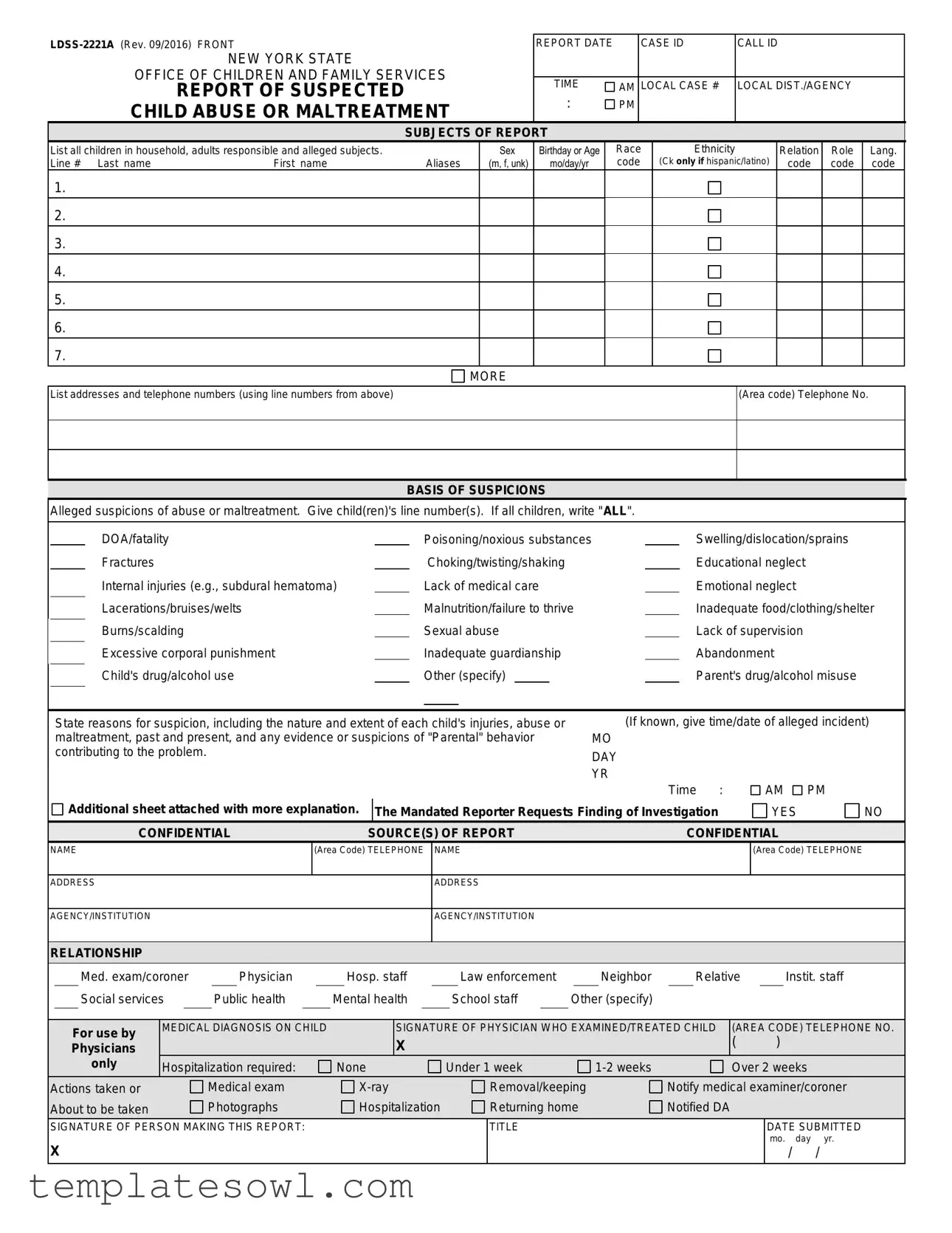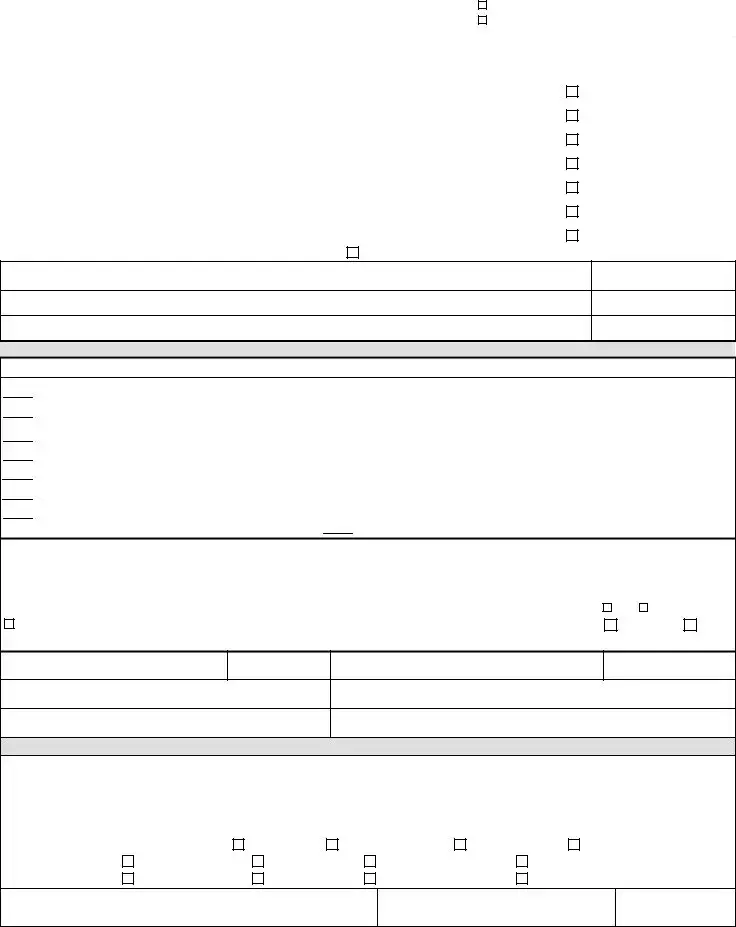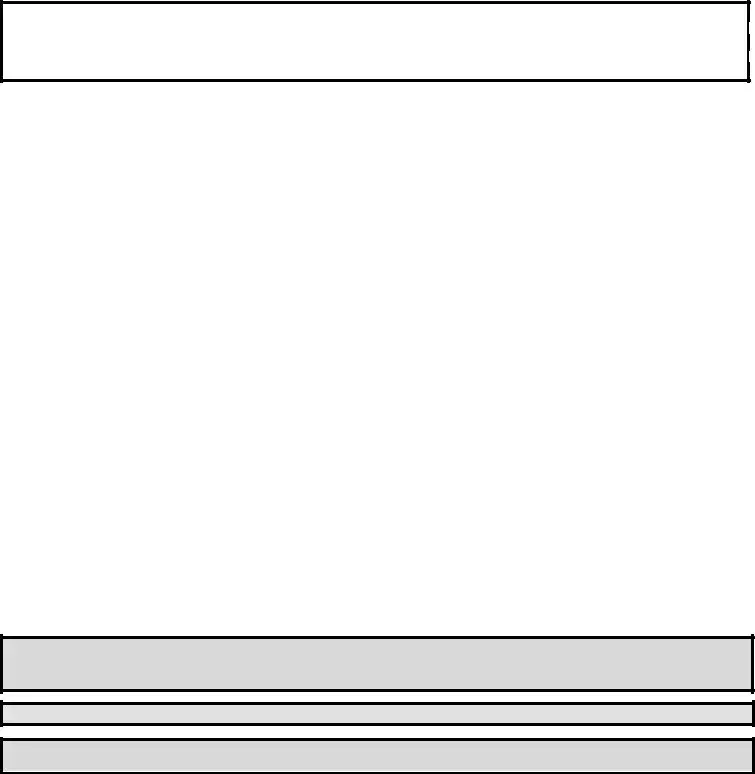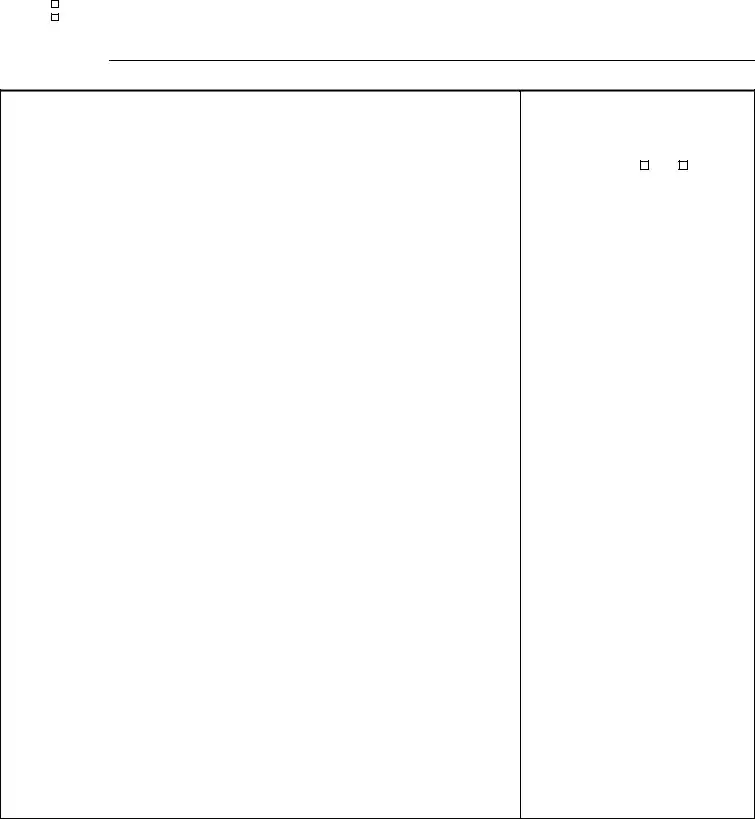LDSS-2221A (Rev. 09/2016) REVERSE
TO ACCESS A COPY OF THE LDSS-2221A FORM: Via Internet: http://ocfs.ny.gov/main/documents/forms_keyword.asp OR
TO ORDER A SUPPLY OF FORMS ACCESS FORM (OCFS-4627) Request for Forms and Publications, from the site above, fill it out and send to: THE OFFICE OF CHILDREN AND FAMILY SERVICES, FORMS AND PUBLICATIONS UNIT, 52 WASHINGTON ST. ROOM 134 NORTH, RENSSELAER, NY 12144-2834. If you have difficulty accessing this form from either site, you can call the Forms Order Line at 518-473-0971. Leave a detailed message including your name, address, city, state, the form number you need, the quantity and a phone number in case we need to contact you.
NEW YORK STATE OFFICE OF CHILDREN AND FAMILY SERVICES
|
RACE |
|
|
ETHNICITY |
|
|
RELATION CODES |
|
|
ROLE |
|
|
LANGUAGE |
|
|
CODE |
|
|
CODE |
|
|
FAMILIAL REPORTS |
|
|
CODE |
|
|
|
CODE |
|
|
|
|
|
|
|
|
(Choose One) |
|
|
(Choose One) |
|
|
|
|
|
|
|
|
(Choose One) |
|
|
|
|
|
AA: Black or African-American |
(Check Only If |
AU: Aunt/Uncle |
XX: Other |
AB: Abused child |
CH: Chinese |
KR: Korean |
AL: Alaskan Native |
Hispanic/ Latino) |
CH: Child |
PA: Parent |
MA: Maltreated child |
CR: Creole |
MU: Multiple |
|
|
|
AS: Asian |
|
|
|
GP: Grandparent |
PS: Parent substitute |
AS: Alleged subject |
EN: English |
PL: Polish |
NA: Native American |
|
|
|
FM: Other family member |
UH: Unrelated home member |
|
(perpetrator) |
FR: French |
RS: Russian |
PI: Native Hawaiian/Pacific Islander |
|
|
|
FP: Foster parent |
UK: Unknown |
NO: No role |
GR: German |
SI: Sign |
WH: White |
|
|
|
DC: Daycare provider |
|
|
UK: Unknown |
HI: Hindi |
SP: Spanish |
XX: Other |
|
|
|
|
IAB REPORTS ONLY |
|
|
|
|
HW: Hebrew |
VT: Vietnamese |
UNK: Unknown |
|
|
|
|
AR: Administrator |
IN: Instit. non-prof |
|
|
|
IT: Italian |
XX: Other |
|
|
|
|
|
|
|
CW: Child care worker |
IP: Instit. pers/vol. |
|
|
|
JP: Japanese |
|
|
|
|
|
|
|
|
|
DO: Director/operator |
PI: Psychiatric staff |
|
|
|
|
|
|
|
|
|
|
|
|
|
|
|
|
|
|
|
|
|
|
|
|
Abstract of Sections from Article 6, Title 6, Social Services Law
Section 412. Definitions
1.Definition of Child Abuse, (see also N.Y.S. Family Court Act Section 1012(e))
An “abused child” is a child less than eighteen years of age whose parent or other person legally responsible for his care:
1)inflicts or allows to be inflicted upon the child serious physical injury, or
2)creates or allows to be created a substantial risk of physical injury, or
3)commits sexual abuse against the child or allows sexual abuse to be committed.
2.Definition of Child Maltreatment, (see also N.Y.S. Family Court Act, Section 1012(f))
A “maltreated child” is a child under eighteen years of age whose physical, mental or emotional condition has been impaired or is in imminent danger of becoming impaired as a result of the failure of his parent or other person legally responsible for his care to exercise a minimum degree of care:
1)in supplying the child with adequate food, clothing, shelter, education, medical or surgical care, though financially able to do so or offered financial or other reasonable means to do so; or
2)in providing the child with proper supervision or guardianship; or
3)by unreasonably inflicting, or allowing to be inflicted, harm or a substantial risk thereof, including the infliction of excessive corporal punishment; or
4)by misusing a drug or drugs; or
5)by misusing alcoholic beverages to the extent that he loses self-control of his actions; or
6)by any other acts of a similarly serious nature requiring the aid of the Family Court; or
7)by abandoning the child.
Section 415. Reporting Procedure. Reports of suspected child abuse or maltreatment shall be made immediately by telephone and in writing within 48 hours after such oral report.
Submit the written paper copy of the LDSS-2221A form originally signed to: the Local County Department of Social Services
(LDSS) where the abused/maltreated child resides.
To locate your Local Department of Social Services, visit this site http://www.ocfs.state.ny.us/main/localdss.asp.
Residential institutional abuse reports: Call 1-855-373-2122 or go online to: http://www.justicecenter.ny.gov/.
NYS CHILD ABUSE AND MALTREATMENT REGISTER: 1-800-635-1522 (FOR MANDATED REPORTERS ONLY) 1-800-342-3720 (FOR PUBLIC CALLERS)
Section 419. Immunity from Liability, Pursuant to section 419 of the Social Services Law, any person, official, or institution participating in good faith in the making of a report of suspected child abuse or maltreatment, the taking of photographs, or the removal or keeping of a child pursuant to the relevant provisions of the Social Services Law shall have immunity from any liability, civil or criminal, that might otherwise result by reason of such actions. For the purpose of any proceeding, civil or criminal, the good faith of any such person, official, or institution required to report cases of child abuse or maltreatment shall be presumed, provided such person, official or institution was acting in discharge of their duties and within the scope of their employment, and that such liability did not result from the willful misconduct or gross negligence of such person, official or institution.
Section 420. Penalties for Failure to Report.
1.Any person, official, or institution required by this title to report a case of suspected child abuse or maltreatment who willfully fails to do so shall be guilty of a class A misdemeanor.
2.Any person, official, or institution required by this title to report a case of suspected child abuse or maltreatment who knowingly and willfully fails to do so shall be civilly liable for the damages proximately caused by such failure.
LDSS-2221A (Rev. 09/2016) ATTACHMENT
STAPLE TO LDSS-2221A (IF NEEDED)
REPORT OF SUSPECTED
CHILD ABUSE OR MALTREATMENT
(Use only if the space on the LDSS-2221A under “Reasons for Suspicion” is not enough to accommodate your information)
REPORT DATE |
CASE ID |
CALL ID |
|
|
|
|
TIME |
AM |
LOCAL CASE # |
LOCAL DIST/AGENCY |
: |
|
|
PM |
|
|
|
|
|
|
|
|
|
PERSON MAKING
THIS REPORT:
Print clearly if filling out hard copy.
Continued: State reasons for suspicion, including the nature and extent of each child's injuries, abuse or maltreatment, past and present, and any evidence or suspicions of "Parental" behavior contributing to the problem.
(If known, give time/date of alleged incident)
MO
DAY
YR



